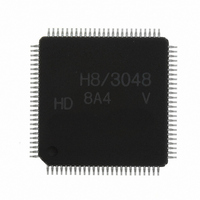HD64F3048VTF8 Renesas Electronics America, HD64F3048VTF8 Datasheet - Page 555

HD64F3048VTF8
Manufacturer Part Number
HD64F3048VTF8
Description
IC H8 MCU FLASH 128K 100-QFP
Manufacturer
Renesas Electronics America
Series
H8® H8/300Hr
Datasheet
1.HD64F3048F16.pdf
(907 pages)
Specifications of HD64F3048VTF8
Core Processor
H8/300H
Core Size
16-Bit
Speed
8MHz
Connectivity
SCI, SmartCard
Peripherals
DMA, PWM, WDT
Number Of I /o
70
Program Memory Size
128KB (128K x 8)
Program Memory Type
FLASH
Ram Size
4K x 8
Voltage - Supply (vcc/vdd)
2.7 V ~ 5.5 V
Data Converters
A/D 8x10b; D/A 2x8b
Oscillator Type
Internal
Operating Temperature
-20°C ~ 75°C
Package / Case
100-TQFP, 100-VQFP
Lead Free Status / RoHS Status
Contains lead / RoHS non-compliant
Eeprom Size
-
Other names
HD64F3048VX8
- Current page: 555 of 907
- Download datasheet (6Mb)
Interrupt Operations: The smart card interface has three interrupt sources: transmit-data-empty
(TXI), transmit/receive-error (ERI), and receive-data-full (RXI). The transmit-end interrupt
request (TEI) is not available in smart card mode.
A TXI interrupt is requested when the TEND flag is set to 1 in SSR. An RXI interrupt is requested
when the RDRF flag is set to 1 in SSR. An ERI interrupt is requested when the ORER, PER, or
ERS flag is set to 1 in SSR. These relationships are shown in table 14.8.
Table 14.8 Smart Card Mode Operating States and Interrupt Sources
Operating State
Transmit mode
Receive mode
Data Transfer by DMAC: The DMAC can be used to transmit and receive in smart card mode,
as in normal SCI operations. In transmit mode, when the TEND flag is set to 1 in SSR, the TDRE
flag is set simultaneously, generating a TXI interrupt. If TXI is designated in advance as a DMAC
activation source, the DMAC will be activated by the TXI request and will transfer the next
transmit data. This data transfer by the DMAC automatically clears the TDRE and TEND flags to
0. When an error occurs, the SCI automatically retransmits the same data, keeping TEND cleared
to 0 so that the DMAC is not activated. The SCI and DMAC will therefore automatically transmit
the designated number of bytes, including retransmission when an error occurs. When an error
occurs the ERS flag is not cleared automatically, so the RIE bit should be set to 1 to enable the
error to generate an ERI request, and the ERI interrupt handler should clear ERS.
When using the DMAC to transmit or receive, first set up and enable the DMAC, then make SCI
settings. DMAC settings are described in section 8, DMA Controller.
In receive operations, when the RDRF flag is set to 1 in SSR, an RXI interrupt is requested. If RXI
is designated in advance as a DMAC activation source, the DMAC will be activated by the RXI
request and will transfer the received data. This data transfer by the DMAC automatically clears
the RDRF flag to 0. When an error occurs, the RDRF flag is not set and an error flag is set instead.
The DMAC is not activated. The ERI interrupt request is directed to the CPU. The ERI interrupt
handler should clear the error flags.
Normal operation
Error
Normal operation
Error
TEND
RDRF
Flag
ERS
PER, ORER
Rev. 7.00 Sep 21, 2005 page 529 of 878
Mask Bit
TIE
RIE
RIE
RIE
Section 14 Smart Card Interface
Interrupt
Source
TXI
ERI
RXI
ERI
REJ09B0259-0700
DMAC
Activation
Available
Not available
Available
Not available
Related parts for HD64F3048VTF8
Image
Part Number
Description
Manufacturer
Datasheet
Request
R

Part Number:
Description:
KIT STARTER FOR M16C/29
Manufacturer:
Renesas Electronics America
Datasheet:

Part Number:
Description:
KIT STARTER FOR R8C/2D
Manufacturer:
Renesas Electronics America
Datasheet:

Part Number:
Description:
R0K33062P STARTER KIT
Manufacturer:
Renesas Electronics America
Datasheet:

Part Number:
Description:
KIT STARTER FOR R8C/23 E8A
Manufacturer:
Renesas Electronics America
Datasheet:

Part Number:
Description:
KIT STARTER FOR R8C/25
Manufacturer:
Renesas Electronics America
Datasheet:

Part Number:
Description:
KIT STARTER H8S2456 SHARPE DSPLY
Manufacturer:
Renesas Electronics America
Datasheet:

Part Number:
Description:
KIT STARTER FOR R8C38C
Manufacturer:
Renesas Electronics America
Datasheet:

Part Number:
Description:
KIT STARTER FOR R8C35C
Manufacturer:
Renesas Electronics America
Datasheet:

Part Number:
Description:
KIT STARTER FOR R8CL3AC+LCD APPS
Manufacturer:
Renesas Electronics America
Datasheet:

Part Number:
Description:
KIT STARTER FOR RX610
Manufacturer:
Renesas Electronics America
Datasheet:

Part Number:
Description:
KIT STARTER FOR R32C/118
Manufacturer:
Renesas Electronics America
Datasheet:

Part Number:
Description:
KIT DEV RSK-R8C/26-29
Manufacturer:
Renesas Electronics America
Datasheet:

Part Number:
Description:
KIT STARTER FOR SH7124
Manufacturer:
Renesas Electronics America
Datasheet:

Part Number:
Description:
KIT STARTER FOR H8SX/1622
Manufacturer:
Renesas Electronics America
Datasheet:











